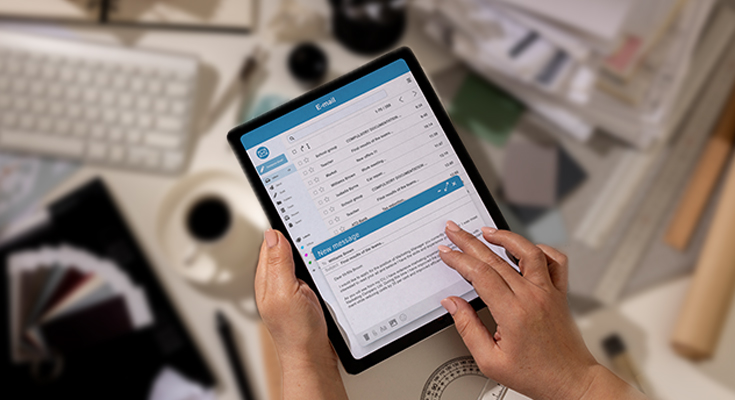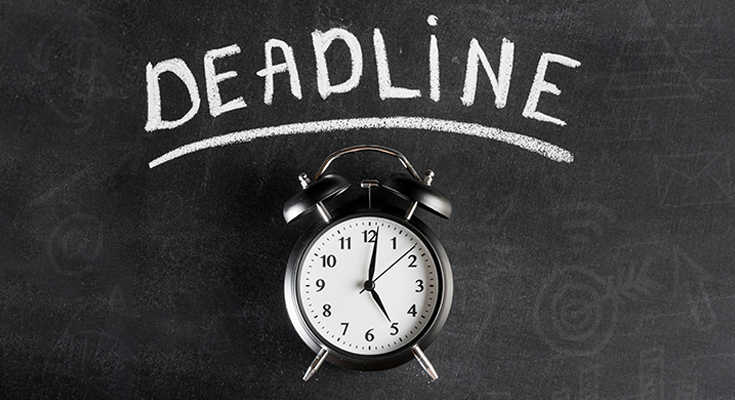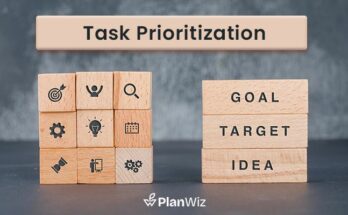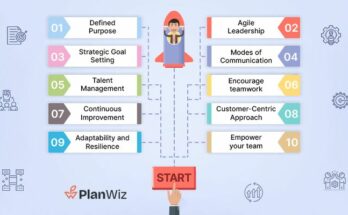Transform your planner into a powerhouse of organization with our expert tips! Say goodbye to chaos and hello to success with our 10 foolproof planner organization ideas. Learn how to maximize your planner’s space and effortlessly reach your goals. Follow our easy steps to turn your planner into a tool for success and chase your dreams with confidence!
Discover 10 simple planner organization ideas in this blog to propel you toward your dreams. From color-coding techniques to habit trackers, unlock the potential of your planner as a catalyst for success. Streamline your routines and pave a clear path to realizing your aspirations with these practical tips. Let’s turn your planner into your steadfast companion on the journey to achievement.
1. Select the Appropriate Planner:
Choosing the right planner is essential for effective organization and productivity. It begins with understanding your unique needs and preferences. Consider factors such as the number of daily tasks, scheduling preferences, and whether you prefer digital or physical planning methods.
Exploring the various formats available is crucial. Daily planners offer detailed scheduling for busy individuals, while weekly or monthly layouts provide a broader overview. Select a format that aligns with your planning style and helps you manage your time efficiently.

Customization features can enhance the usability of your planner. Look for options to tailor sections, layouts, and additional features such as goal-setting pages or habit trackers. Personalizing your planner ensures it meets your specific requirements and maximizes its effectiveness.
Mobility and accessibility are vital considerations. Determine whether you need a digital planner accessible on your devices or prefer the convenience of a physical planner you can carry with you. Choose a planner that fits seamlessly into your daily routine.
Lastly, review your budget and the value offered by different planner’s organization ideas. While some may come at a higher price with advanced features, others may offer sufficient functionality at a more affordable cost. Strike a balance between cost and features to make an informed decision that meets your needs without overspending.
2. Allocate Time for Planning:

- Planning is vital, requiring dedicated time for brainstorming and outlining objectives to set a clear direction for execution.
- Allocating time for thorough analysis involves breaking down tasks, estimating resources, and understanding project scope, ensuring comprehensive planning.
- Effective planning, which includes time for research and gathering information, is essential for well-informed decision-making and the development of organizational strategies.
- Communication and collaboration time during planning facilitate idea sharing, feedback collection, and alignment of stakeholders’ expectations.
- Allocating time for review and adjustment enables adaptive planning, allowing for course correction, adaptation to unforeseen circumstances, and incorporation of new insights.
- Dedicate time initially for brainstorming and outlining objectives to provide clarity and set the stage for efficient execution.
- Allocate time for thorough analysis, including breaking down tasks and estimating resources, ensuring a comprehensive understanding of project scope.
- Effective planning involves allocating time for research and gathering information to inform decision-making and develop a well-informed strategy.
3. Choose a Planning System:
Planning systems play a crucial role in organizing and executing tasks efficiently. Selecting the right planning system is essential for personal productivity or business strategy. Flexibility, scalability, and user-friendliness must be considered to ensure effectiveness.
One popular planning system is the Eisenhower Matrix, which categorizes tasks based on urgency and importance. This system helps individuals prioritize tasks effectively, focusing on what truly matters. By dividing tasks into four quadrants, it aids in decision-making and time management.

Another widely used planning system is the Kanban method, originating from Japanese manufacturing processes. Kanban visualizes workflow through boards, cards, and columns, allowing teams to track progress and manage tasks efficiently. Its simplicity and adaptability make it suitable for various industries and projects.
The Getting Things Done (GTD) method, developed by David Allen, offers a comprehensive approach to task management, including planner organization ideas. It emphasizes capturing, clarifying, organizing, and reviewing tasks to achieve a clear mind and enhanced productivity. GTD provides a systematic way to handle tasks and reduce mental clutter.
Agile planning methodologies, such as Scrum and Agile boards, are popular in software development and project management. These systems promote iterative development, frequent collaboration, and adaptability to change. Agile methodologies enable teams to deliver high-quality results while responding effectively to evolving requirements.
4. Note Down Everything:
Note Down Everything is a practice that advocates for capturing all relevant information, ideas, and tasks. This approach ensures that nothing important slips through the cracks and provides a comprehensive record for future reference. By noting down everything, individuals can maintain clarity and organization in their thoughts and actions.
Effective note-taking is essential for memory retention and information management. Whether in academic, professional, or personal contexts, jotting down key points helps reinforce learning and understanding. Moreover, thorough notes are valuable resources for reviewing and revisiting topics, enhancing comprehension and knowledge retention over time.

Various methods and tools exist for note-taking, catering to different preferences and needs. From traditional handwritten notes to digital platforms and voice recordings, individuals have a range of options to choose from. For example, some may prefer the tactile experience of pen and paper, while others appreciate the convenience and accessibility of digital note-taking apps.
Popular note-taking strategies include the Cornell method, which organizes notes into sections for main points, supporting details, and summaries. Another technique is mind mapping, which visually represents relationships between concepts, fostering creativity and critical thinking. Additionally, bullet journaling combines note-taking with task management, enabling users to track goals and priorities effectively.
In workplaces, taking notes is super important for good teamwork and getting stuff done. Things like meeting notes, project plans, and to-do lists all help make sure everyone knows what’s going on and who’s responsible for what. Incorporating Planner organization ideas, when we write down important stuff, it helps us work better together and reach our goals faster.
5. Arrange Your Tasks by Category:

- Categorizing tasks by nature or purpose enhances time management by enabling effective prioritization and focus, whether in work-related, personal, or academic settings.
- Grouping work-related tasks by project or client facilitates efficient management, collaboration, and progress tracking, ensuring no important task is overlooked.
- Sorting personal tasks by urgency or type, such as chores or appointments, aids in balancing personal and professional life, preventing essential activities from being missed.
- In academic settings, categorizing tasks by subject, deadlines, or importance helps students focus and manage study time effectively, reducing overwhelm and enhancing productivity.
- Organizing volunteer or community work tasks by project or event streamlines planning and execution, ensuring efficient resource utilization and fostering teamwork and accountability.
- Prioritizing tasks based on their nature or purpose enables better planning and ensures all aspects of a project or goal are addressed adequately.
- Categorization assists in tracking progress effectively, allowing for adjustments and improvements in time management tips as needed.
- Whether in work, personal, academic, or volunteer contexts, organizing tasks by category enhances efficiency, productivity, and overall effectiveness in time management.
6. Keep All Your Notes in One Place:
Keeping all your notes in one place is essential for staying organized and efficient. With various platforms and apps available, consolidating your notes streamlines your workflow and ensures you can access important information whenever needed.
One significant advantage of centralizing your notes is the ability to access them from any device with internet connectivity. Whether you’re using a smartphone, tablet, or computer, having your notes synchronized across all your devices ensures you’re always prepared, regardless of where you are.

By consolidating your notes with Planner organization ideas in mind, you reduce the risk of losing valuable information. Instead of scattering notes across different notebooks or digital platforms, having everything in one location makes it easier to locate specific details and prevents the frustration of searching through multiple sources.
Organizing your notes in one place allows for better categorization and tagging, facilitating quick retrieval of information. With features such as folders, labels, and search functions, you can effortlessly navigate through your notes, saving time and enhancing productivity in your daily tasks.
Centralizing your notes makes life easier, keeping everything in one place for quick access and better organization. Whether you’re studying, working, or pursuing hobbies, this practice boosts efficiency and helps you stay on top of things.
7. Identify and Prioritize the Top Three Most Important Tasks:
At the core of our productivity approach is simplicity and focus. We believe in the power of writing down our top three goals for the week in a specific spot in our planners, such as the designated section provided by Planwiz Planner. Just like jotting down to-do lists on paper, this practice keeps our priorities front and center.
We know that seeing these goals daily serves as a gentle reminder to stay on track. By focusing on just three things, we cut through the noise and concentrate on what truly matters.

We aim not only to stay busy but to make meaningful progress toward our goals. With this practice, we stay connected to our aspirations and make steady strides toward success.
Together, we create a culture of productivity where clarity and focus drive our actions. With our top three goals guiding us, we navigate each day with purpose, knowing that every step forward brings us closer to our dreams.
8. Assign Deadlines to Tasks:

- Deadlines, along with effective task prioritization, help us understand when tasks should be finished, aiding us in staying organized with our Planner organization ideas.
- They make us feel like we need to get things done quickly, so we focus and work faster.
- When deadlines are clear, it’s easier to manage our time well and make sure tasks are finished on time.
- Deadlines also make sure everyone knows when their part of the job needs to be done, which helps teamwork.
- Meeting deadlines shows others they can trust us to get things done on time, which is important.
- They let us see how we’re doing on a project and if we need to change anything to finish on time.
- Overall, deadlines give us a target to aim for, making us work harder to get things done when we need to.
- So, setting deadlines is a great way to keep us on track and get things done efficiently.
9. Use Digital Inserts for Important Big Projects:
Digital inserts serve as invaluable tools for managing crucial large-scale projects efficiently. These inserts, integrated into project management systems, offer dynamic functionalities that enhance coordination, communication, and organization. By utilizing digital inserts, teams can streamline complex workflows, ensuring smoother project execution and timely delivery of results.
One key benefit of employing digital inserts for significant projects is their ability to centralize essential information. With these inserts, teams can consolidate project plans, timelines, and resources in one accessible platform. This centralized approach minimizes confusion and ensures that all team members are aligned with project goals, leading to enhanced productivity and collaboration.

Digital inserts help keep track of how projects are going and how well they’re doing. With interactive dashboards and reports, everyone involved can see important information, find any problems quickly, and make decisions based on facts. This helps teams deal with issues early on and keep projects moving forward, even if unexpected things come up.
Digital inserts make it easy for people involved in a project to talk and work together smoothly. With messaging and file-sharing features built in, team members can share ideas, give feedback, and get the files they need without any hassle. This helps create a culture where everyone feels involved and responsible for making the project successful.
10. Promote a Habit of Thankfulness:
Amid busy schedules and ambitious goal-setting, it’s easy to overlook the importance of gratitude. However, incorporating a habit of gratitude into our planning organization can significantly enhance our overall well-being and sense of fulfillment.
Consider dedicating a section of your planner each day or week to jot down things you’re grateful for. This simple practice, known as Planner organization ideas, can shift your focus from what’s lacking to what’s abundant in your life, fostering a positive mindset and greater resilience in the face of challenges.
Expressing gratitude for the progress you’ve made, the support you’ve received, or even the lessons learned from setbacks can instill a sense of purpose and motivation to keep pushing forward toward your dreams.

reflecting on what you’re grateful for can provide valuable perspective during times of stress or uncertainty. It reminds you of the many blessings in your life and encourages a mindset of abundance rather than scarcity.
By integrating gratitude into your planner organization routine, you not only enhance your productivity and goal attainment but also cultivate a deeper sense of joy and fulfillment in your everyday life.
Final Thoughts:
Transform your planner into a powerhouse of organization with these ten simple yet effective ideas. From choosing the right planner to fostering gratitude, streamline your planning process and move closer to your goals. Maximize your planner’s potential for success in personal, professional, or academic pursuits by implementing these strategies.
Use your planner wisely by thinking about what you need, making time for planning, and trying out popular techniques. Being thankful can help you feel happier and get more done. Let’s use our planners to turn our dreams into reality!




